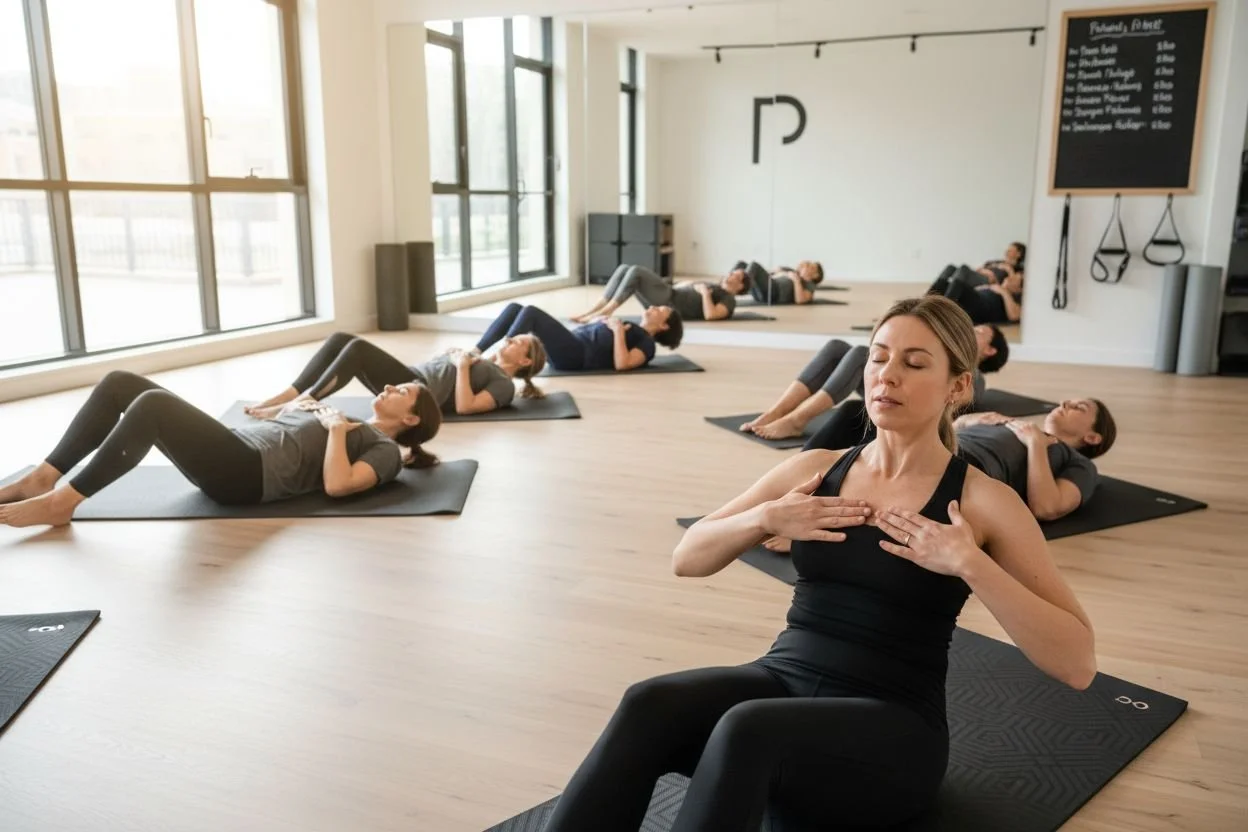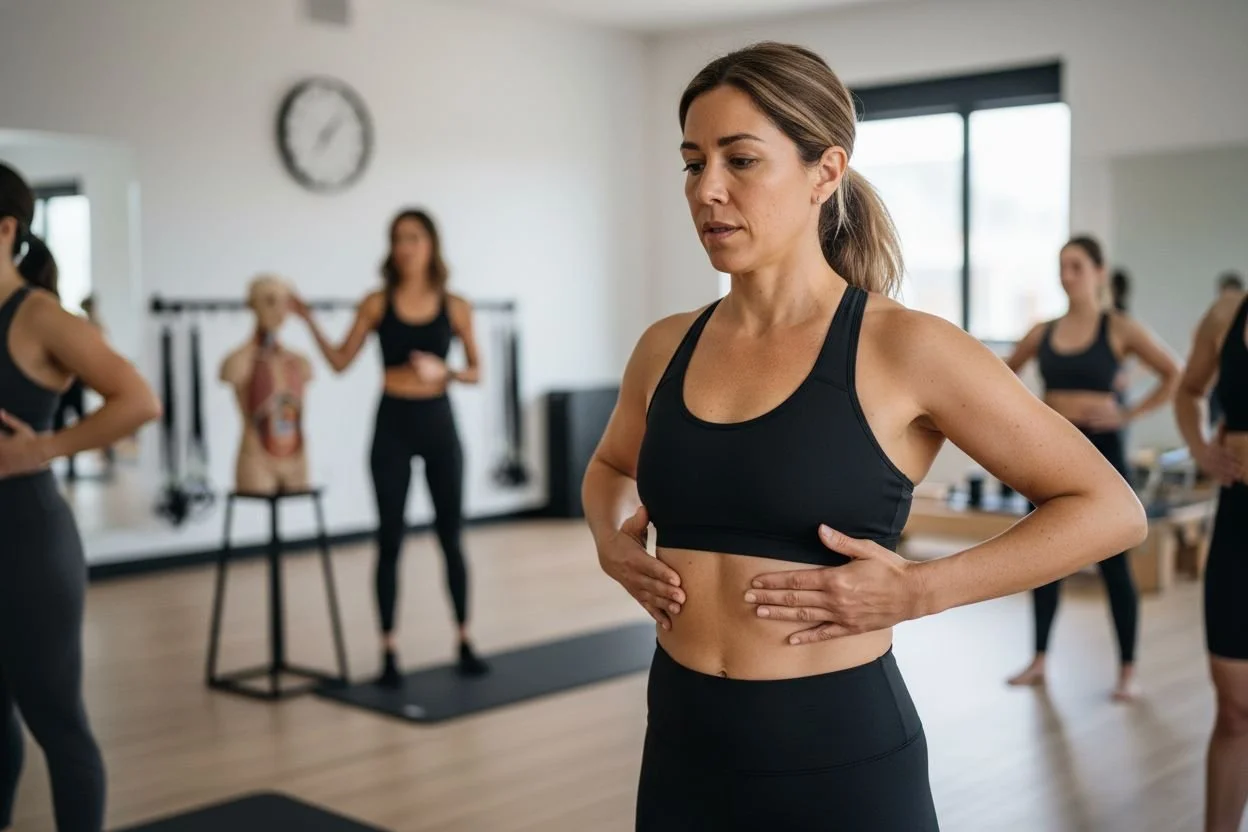Complete Guide to Breathwork in Pilates Practice
Heather Rice
Did you know that coordinated breathwork in Pilates can increase core muscle activation by up to 30 percent? Mindful breathing transforms every move, turning simple exercises into powerful experiences for both body and mind. For anyone looking to achieve smoother motion, sharper focus, and lasting stress relief, understanding how breath shapes Pilates offers a direct path to deeper strength and a calmer, more connected self.
Key Takeaways
| Point | Details |
|---|---|
| Importance of Breathwork | Breathwork in Pilates integrates movement and mindfulness, enhancing both physical and mental experiences. |
| Core Techniques | Lateral ribcage and diaphragmatic breathing are essential, focusing on oxygen flow and core muscle activation. |
| Enhancing Movement | Synchronizing breath with movement amplifies core engagement, stability, and fluid motion. |
| Mental Benefits | Pilates breathwork fosters emotional recovery and resilience, improving focus and overall well-being. |
Table of Contents
Defining Breathwork in Pilates Practice
Breathwork in Pilates represents a fundamental practice that transforms physical movement into a mindful, integrated experience. According to pilates research on mind-body techniques, it acts as a form of moving meditation, creating deep connections between muscular engagement and conscious breathing. Unlike casual breathing, Pilates breathwork is deliberate, precise, and serves multiple physiological and psychological purposes.
According to experts, proper Pilates breathwork involves strategic respiratory techniques designed to activate core muscle groups. Research indicates that this approach specifically targets deep core muscles like the transverse abdominis and pelvic floor, which are critical for maintaining stability and generating powerful, controlled movements. The breathing patterns help practitioners:
Improve overall muscular endurance
Enhance body awareness
Establish a stronger mind-body connection
Reduce physical and mental stress
The primary goal of breathwork in Pilates is not just respiratory efficiency, but creating a holistic movement experience where breath becomes the primary driver of physical expression. By synchronizing breath with movement, practitioners learn to initiate exercises from their core, generating power from the body's center and maintaining precise, controlled motions. This approach transforms Pilates from a simple exercise routine into a sophisticated method of physical and mental conditioning.
Core Breathing Techniques and Variations
Pilates offers several sophisticated breathing techniques that transform movement from mechanical exercise to mindful practice. Research from Pilates experts highlights lateral ribcage breathing as a fundamental technique, which involves expanding the ribs side to side to enhance oxygen flow, increase lung capacity, and support emotional recovery by activating the parasympathetic nervous system.
Diaphragmatic breathing represents another critical technique in Pilates practice. According to advanced breathwork studies, this method focuses on effectively engaging the diaphragm to activate core muscles like the pelvic floor and transverse abdominis. The strategic coordination of breath involves:
Inhaling to prepare the body for movement
Exhaling during physical exertion
Promoting smoother, more controlled motion
Increasing overall body awareness
These breathing variations are not merely technical exercises but transformative practices that connect physical movement with internal energy. By mastering these techniques, practitioners can develop a more profound understanding of their body's mechanics, reducing unnecessary tension and creating more efficient, graceful movements that integrate breath, core strength, and mindful awareness.
Here's a summary of the main Pilates breathwork techniques:
Pilates Breathing Techniques
| Technique | Key Focus | Primary Benefits |
|---|---|---|
| Lateral Ribcage Breathing | Rib expansion Lung capacity |
Increased oxygen flow Relaxation |
| Diaphragmatic Breathing | Diaphragm Core activation |
Core strength Smoother motion |
How Breath Integrates With Pilates Exercises
Breath integration is the cornerstone of effective Pilates practice, transforming physical movements into a holistic mind-body experience. According to Pilates experts, specific exercises like the Hundred, Rolling Like a Ball, and the Teaser demonstrate how precisely synchronized breathing can enhance blood flow, activate core muscles, and improve spinal mobility.
The fundamental principle of breath integration involves strategic timing and coordination. Research on Pilates breathwork reveals a critical pattern of breath synchronization: typically inhaling during movement preparation and exhaling during exercise execution. This approach offers multiple benefits:
Enhanced core muscle engagement
Improved overall body stability
Greater motion fluidity
Deeper mind-body connection
Increased concentration and body awareness
By treating breath as an active participant rather than a passive background function, practitioners learn to generate movement from their core's center. The breath becomes a powerful tool that guides muscular activation, supports precise movement patterns, and creates a seamless flow between physical exertion and mindful awareness. This intricate relationship between breath and movement is what elevates Pilates from a simple exercise routine to a sophisticated method of physical and mental conditioning.
Major Physical and Mental Health Benefits
Pilates breathwork offers a comprehensive approach to wellness, delivering profound physical and mental health advantages that extend far beyond traditional exercise routines. Research from Pilates experts reveals that this practice significantly improves core engagement, muscular endurance, and overall body alignment while simultaneously supporting physiological recovery mechanisms.
The physical benefits are particularly remarkable. According to scientific studies, practitioners experience multiple transformative outcomes:
Enhanced core muscle strength
Improved posture and body alignment
Increased oxygen delivery throughout the body
Better muscular endurance
Support for emotional recovery
Mentally, Pilates breathwork serves as a powerful tool for psychological resilience. By activating the parasympathetic nervous system, these techniques provide a profound mechanism for stress reduction, fostering inner calm and emotional equilibrium. Practitioners report significant improvements in focus, mental clarity, and overall emotional well-being, effectively turning breathwork into a moving meditation that supports mental health both inside and outside the studio. The integration of breath and movement becomes a holistic practice that nurtures the mind-body connection, offering a comprehensive approach to personal wellness.
Common Mistakes and Corrective Strategies
Breath control in Pilates can be challenging, especially for beginners who are still developing body awareness and understanding the intricate relationship between movement and breathing. According to fitness experts, one of the most prevalent mistakes is holding breath during physical exertion, which dramatically limits oxygen flow and increases exercise difficulty.
The most critical breathing mistakes practitioners encounter include:
Holding breath during challenging movements
Breathing irregularly or inconsistently
Shallow chest breathing instead of deep diaphragmatic breathing
Disconnecting breath from movement
Overthinking breathing techniques
To address these challenges, Pilates instructors recommend several corrective strategies. The primary approach involves practicing controlled breathing by deliberately exhaling during exertion and inhaling during recovery phases. This technique not only improves oxygen delivery but also helps engage core muscles more effectively, creating a more fluid and powerful movement pattern. Developing breath awareness takes time and practice, so beginners should focus on mindful, patient learning rather than perfection, allowing their body to gradually synchronize breath and movement in a natural, intuitive progression.
Transform Your Pilates Breathwork Into Lasting Wellness at Amrita Yoga & Wellness
Are you struggling to connect breath with movement in your Pilates practice? If you find yourself holding your breath or feeling disconnected from your core, you’re not alone. Many people face these challenges while aiming to master techniques like lateral ribcage and diaphragmatic breathing. The journey from shallow, irregular breaths to deep, powerful breathwork is not just about exercise—it’s about finding true mind-body harmony and lowering stress in every class.
Take action today and experience what it means to breathe mindfully through every movement. At Amrita Yoga & Wellness, our Pilates and holistic classes are designed to guide you step by step. Connect with a supportive community, dive deeper into expert-led sessions, and explore a full range of offerings that nurture both your body and mind. If you are ready to feel the difference proper breathwork makes, explore our full schedule and book your spot now. Your journey to stronger core engagement, better movement, and calmer living starts here.
Frequently Asked Questions
What is breathwork in Pilates?
Breathwork in Pilates refers to intentional breathing techniques used to enhance physical movement, improve core engagement, and create a deeper mind-body connection during practice.
How does breathwork improve Pilates practice?
Breathwork enhances Pilates by synchronizing breath with movement, which increases blood flow, engages core muscles more effectively, and fosters greater body awareness and emotional balance.
What are some common breathing techniques in Pilates?
Common breathing techniques in Pilates include lateral ribcage breathing, which expands lung capacity, and diaphragmatic breathing, which activates core muscles for smoother and more controlled movement.
What mistakes should beginners avoid with Pilates breathwork?
Beginners should avoid holding their breath during exertion, irregular breathing patterns, and shallow chest breathing. It’s important to practice coordinated breathing by exhaling during exertion and inhaling during recovery.



